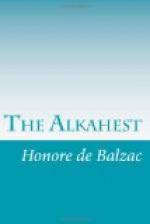The first floor was pierced by five windows, the second by three, while the attic had only one large circular opening in five divisions, surrounded by a freestone moulding and placed in the centre of the triangular pediment defined by the gable-roof, like the rose-window of a cathedral. At the peak was a vane in the shape of a weaver’s shuttle threaded with flax. Both sides of the large triangular pediment which formed the wall of the gable were dentelled squarely into something like steps, as low down as the string-course of the upper floor, where the rain from the roof fell to right and left of the house through the jaws of a fantastic gargoyle. A freestone foundation projected like a step at the base of the house; and on either side of the entrance, between the two windows, was a trap-door, clamped by heavy iron bands, through which the cellars were entered,—a last vestige of ancient usages.
From the time the house was built, this facade had been carefully cleaned twice a year. If a little mortar fell from between the bricks, the crack was instantly filled up. The sashes, the sills, the copings, were dusted oftener than the most precious sculptures in the Louvre. The front of the house bore no signs of decay; notwithstanding the deepened color which age had given to the bricks, it was as well preserved as a choice old picture, or some rare book cherished by an amateur, which would be ever new were it not for the blistering of our climate and the effect of gases, whose pernicious breath threatens our own health.
The cloudy skies and humid atmosphere of Flanders, and the shadows produced by the narrowness of the street, sometimes diminished the brilliancy which the old house derived from its cleanliness; moreover, the very care bestowed upon it made it rather sad and chilling to the eye. A poet might have wished some leafage about the shrine, a little moss in the crevices of the freestone, a break in the even courses of the brick; he would have longed for a swallow to build her nest in the red coping that roofed the arches of the windows. The precise and immaculate air of this facade, a little worn by perpetual rubbing, gave the house a tone of severe propriety and estimable decency which would have driven a romanticist out of the neighborhood, had he happened to take lodgings over the way.




